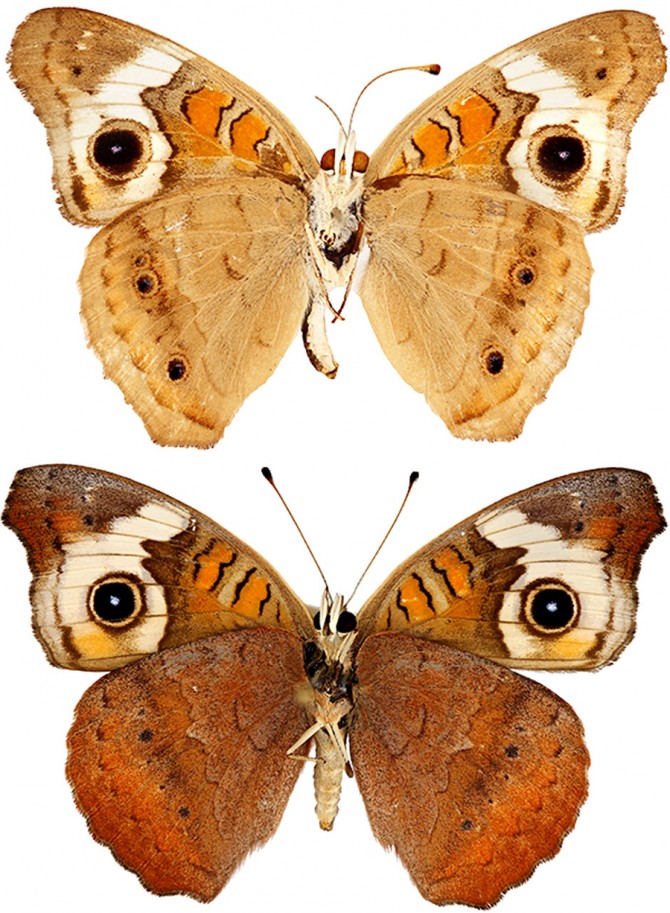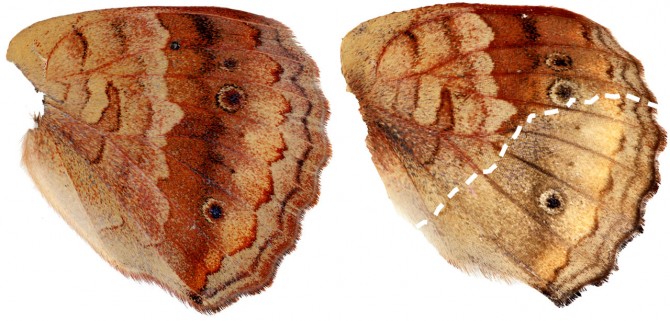Cornell researchers have identified three genes responsible for changing the color of common buckeye butterfly wings, depending on what time of year the egg hatches and larvae develop.
If the larvae develop early in the year, when days are shorter and colder, the butterflies (Junonia coenia) reach maturity in summer with tan wings. But if larvae develop later in the year, when days are longer and warmer, the butterflies mature in fall with reddish wings.
The common buckeye has two seasonal color variations; a tan summer pattern, top, and a red fall pattern, bottom.
The study is important because it identifies the genes that allow an organism to change what it looks like in response to the environment.
"This is one of the first studies I'm aware of where someone has identified specific genes that control the relationship between nature versus nurture," said study senior author Robert Reed, professor of ecology and evolutionary biology in the College of Arts and Sciences and in the College of Agriculture and Life Sciences.
Karin van der Burg, a graduate student in Reed's lab, is first author of "Genomic Architecture of a Genetically Assimilated Seasonal Color Pattern," published Nov. 6 in Science.
"We have some evidence showing that the dark red wings seen in fall, in colder conditions, will help with temperature regulation," van der Burg said. "They warm up faster" as darker colors are good at absorbing light and heat, she said. The reddish color may also help these butterflies camouflage when leaves change color.
While Arctic animals like snowshoe hares darken and lighten back and forth to blend into their surroundings based on seasons, many insects, such as the common buckeye, sense their environments during early life stages and make irreversible developmental decisions, Reed said.
Also, within the species, different common buckeye populations are more responsive than others to the environmental cues. "There's actually genetic variation within a species for this relationship between nature and nurture," Reed said.
In the study, van der Burg created two common buckeye butterfly populations in the lab. One had the ability to change wing color in response to the environment. Then van der Burg used artificial selection to continuously mate individuals that were less responsive to the environment, to eventually select for individuals that were unresponsive to the seasonal signals.
The researchers used gene editing technology to delete genes that control variation in color patterns, which caused the genetic fall pattern, left, to switch to a seasonal summer pattern in some patches.
"After only a few generations, we had two lines, one that had the ability to change color and one that was basically red no matter what conditions we reared them in," she said.
Using a variety of techniques, including genetic mapping and genome-wide association studies, the researchers identified four loci, or areas, in the genome associated with this ability to respond to seasonal cues. They then compared the two lines and looked at which genes were expressed differently in these loci. They found three genes of interest and - by disabling each of the genes using CRISPR-Cas gene-editing technology and looking at the effects - confirmed they were indeed causing the color shifts.
"If you knock out these genes you see clear change in wing color, where different patches of cells have the red color that is hardwired, or the tan color that is induced by the environment," van der Burg said.
By identifying the specific genes, Reed said, researchers may now explore the mechanisms involved in nature vs. nurture decisions.
The findings also provide evidence for the idea that variation already encoded in the genome can be unlocked by pressures from the environment. The interplay between genetic variation and environmental pressures that lead to permanent genetic changes over time is the basis of natural selection and evolution, Reed said.
The study was funded by the National Science Foundation.








